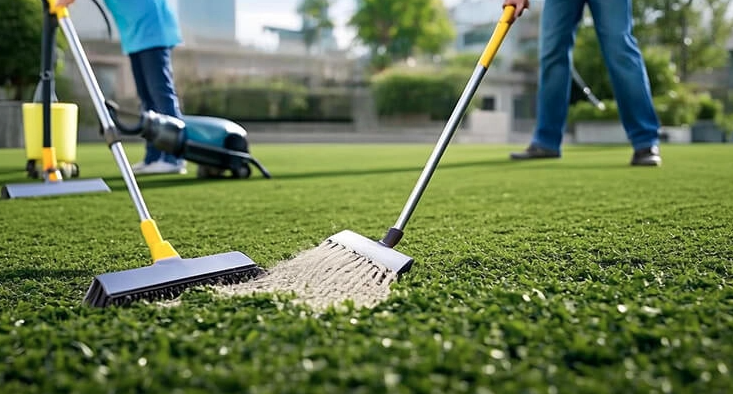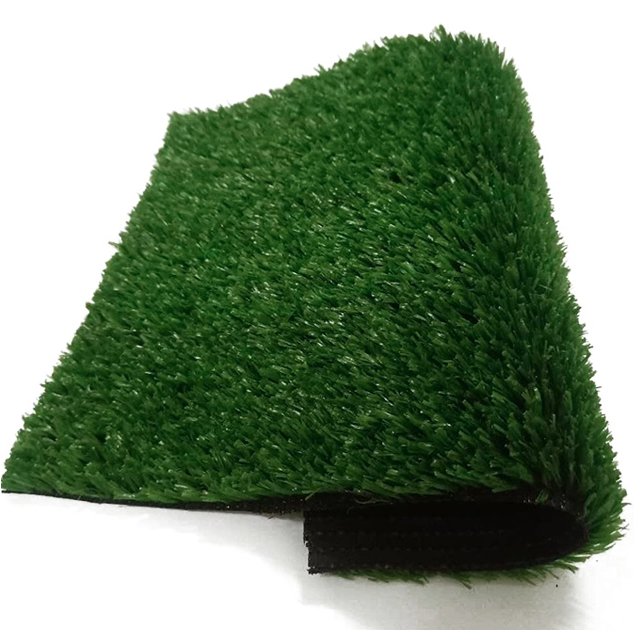
Artificial grass has become a popular choice for homeowners, schools, sports facilities, and commercial landscapes. It stays green year-round, reduces maintenance, and offers a clean, consistent surface. But drainage is one of the most critical aspects of installation. Without proper drainage, water can pool on the surface, damaging the turf and creating safety hazards.
Unlike natural grass, which absorbs water into the soil, artificial turf relies on engineered solutions. The combination of permeable turf backing and a well-prepared sub-base ensures water drains efficiently, even in heavy rain. Proper drainage also prevents mold, unpleasant odors, and degradation of the turf fibers.
How Artificial Grass Drainage Works
Artificial grass drainage depends on two key components working together: the turf backing and the sub-base.
Turf Backing: The First Line of Drainage
The turf backing holds the synthetic grass fibers and allows water to escape. Most artificial lawns use either:
Hole-Punched Backing:
Traditional and widely used for decades.
Features evenly spaced drainage holes to allow water to pass through quickly.
Suitable for gardens, patios, and general landscaping.
100% Permeable Backing:
Ideal for pet lawns, dog runs, or areas with heavy rainfall.
Promotes fast drainage and prevents urine buildup, stains, and bacterial growth.
Modern turf innovations also focus on comfort, lightweight design, and recyclability. For instance, recyclable series turf combines drainage efficiency with sustainability.
Sub-Base: The Supporting Layer
The sub-base sits beneath the turf and provides both stability and drainage. It typically consists of crushed granite, gravel, or decomposed stone.
Key points for sub-base installation:
Excavate 3–4 inches of soil to create space for the base.
Compact the sub-base lightly to maintain porosity while supporting the turf.
Level the surface to prevent low spots that could create puddles.
In clay-heavy or poorly draining soils, consider replacing the existing soil entirely.
A well-prepared sub-base not only allows water to drain but also prevents the turf from settling unevenly, maintaining its appearance and usability for years.
Artificial Grass vs Natural Grass Drainage
Artificial turf offers superior drainage compared to natural grass. Here’s why:
| Feature | Artificial Grass | Natural Grass |
| Drainage Mechanism | Permeable backing + sub-base | Soil absorption, prone to compaction |
| Drainage Speed | Fast and consistent, 30–1,200 in/hr depending on product | Slower, 5–20 in/hr depending on soil |
| Maintenance | Minimal | Needs aeration, soil care, reseeding |
| Rain Performance | Drains quickly, usable immediately | Muddy, slippery, may require drying time |
| Pet Friendly | Fully permeable options prevent urine buildup | Requires extra maintenance, may stain |
Natural grass absorbs water into soil, but heavy rain or compacted soil can create puddles, mud, and slippery surfaces. Artificial grass is engineered to avoid these issues and maintain usability year-round.
Common Causes of Poor Artificial Grass Drainage
Even the highest-quality synthetic turf can experience drainage issues if the installation or site preparation is not done correctly. These problems often stem from either the natural conditions of the garden or errors made during the turf installation process. Understanding these factors helps homeowners and installers prevent long-term issues and maintain the appearance and functionality of their artificial lawn.
Geological Factors
Clay-rich soils are notorious for holding water and slowing drainage, which can lead to persistent puddles on the surface of the turf. Gardens located in low-lying areas are naturally prone to collecting runoff from surrounding land, increasing the risk of waterlogging. Uneven terrain can also create small dips or depressions, where water naturally accumulates and remains trapped. In addition, a high water table beneath the garden prevents water from moving downward efficiently, saturating both the turf and the sub-base, which can damage the grass fibers and reduce its lifespan.
Installation Errors
Drainage problems can also arise from mistakes made during the artificial grass installation. Using the wrong infill, such as heavy or non-permeable materials, can block the drainage holes in the turf backing, slowing or even stopping water flow. Inadequate preparation or improper compaction of the sub-base can trap water beneath the surface, creating soft spots and instability. Installing turf over non-porous surfaces like concrete, tiles, or decking without additional drainage solutions can lead to water pooling. Finally, neglecting to create a slight slope during installation can prevent water from flowing naturally, leaving the surface wet and unusable after rainfall.
How to Prevent Artificial Grass Drainage Problems
Most artificial grass drainage issues can be avoided by taking time to evaluate the garden, understanding how water behaves on the property, and ensuring each installation step supports proper water flow. When these factors come together, the turf drains efficiently, stays cleaner, and lasts far longer without needing costly drainage upgrades.
Step 1: Assess the Garden
Before any installation begins, it’s important to understand the natural characteristics of the outdoor space. Start by identifying the type of soil—clay soils or mixed soils often drain slowly, while sandy soils usually allow water to move freely. Pay attention to where water naturally collects after rainfall, because these dips or low areas often become long-term trouble spots once turf is installed. It also helps to consider the general slope of the garden; even a subtle incline can determine the direction of runoff. If the garden has a history of waterlogging or soggy patches, that information becomes crucial for planning a drainage-friendly installation.
Step 2: Prepare the Sub-Base
A strong, well-designed sub-base is the backbone of effective artificial grass drainage. In gardens with problematic soil, the existing top layer is often removed and replaced with crushed granite, gravel, or a Type 1 sub-base, all of which allow water to move downward more easily. This sub-base should be compacted—firm enough to support the turf but not so dense that it blocks the flow of water. The goal is to create a flat, stable foundation with a gentle 1–2% slope so water can naturally run off instead of pooling. When done right, this step alone eliminates most drainage issues that homeowners typically face.
Step 3: Select Appropriate Turf
Choosing the right turf backing plays a major role in how well the lawn drains. Many homeowners opt for grass with a hole-punched backing, a reliable system that allows rainwater to escape quickly through evenly spaced drainage holes. In areas with heavy rainfall, frequent pet use, or high foot traffic, a fully permeable backing may perform better because it lets water flow through every part of the surface rather than just designated holes. The infill must also work with the drainage system; lightweight, permeable options keep the backing clear, while heavy or dense materials can clog the holes and create slow drainage.
Step 4: Consider Advanced Drainage Solutions
Some gardens require additional drainage structures to manage water effectively. French drains are a popular option, using gravel-filled trenches wrapped in permeable membrane to move water underground and away from the surface. For more serious drainage challenges, piped land drains may be installed, using perforated pipes that gather water and channel it to an external drainage point. These are especially useful for large lawns or gardens positioned in naturally low areas. In urban settings where turf is installed on concrete, tile, or decking, drainage cells provide an open-cell layer beneath the surface, allowing both water and air to move freely and preventing moisture from becoming trapped.
![Grass Carpet Grass Carpet]()
Artificial Grass Drainage on Hard Surfaces
Artificial turf works well on non-soil surfaces but requires careful drainage planning:
Slight Gradient: Even small slope (1–2%) ensures water flows off the surface.
Drainage Holes: Drill 16mm holes at 0.5–1m spacing, filled with pea gravel.
Drainage Cells: Open-cell pads create airflow and quick drying, essential for balconies, rooftops, or concrete patios.
These methods maintain usability, prevent puddles, and reduce odor or bacterial growth.
Modern Turf Drainage Innovations
Recent technologies improve drainage while adding structural support and safety:
Rock-in-Roll Pads: Reduce traditional drainage stone requirement by up to 75%, using encapsulated granules.
ShockDrain Pads: Provide impact attenuation for athletes while channeling water efficiently.
TEPC Materials: Thermoplastic elastomer polyolefin composites maintain shock absorption even when saturated.
Sustainability: Many modern systems are made from recycled materials and reduce stormwater runoff, supporting groundwater recharge.
These solutions are especially valuable for sports fields, playgrounds, and high-traffic areas where both drainage and surface safety are crucial.
FAQ
Q1: Do I need a separate drainage system for artificial grass?
In most cases, no separate drainage system is required because artificial grass is designed with a permeable backing and works with a properly prepared sub-base to channel water efficiently.
Q2: How does artificial grass drain water compared to natural grass?
Artificial grass drains faster and more consistently because water passes through the turf backing and sub-base, while natural grass relies on soil absorption and is prone to puddles and slow drying.
Q3: What types of turf backing improve drainage?
Hole-punched backing allows water to pass through evenly spaced holes, while 100% permeable backing is ideal for heavy rainfall, pet areas, or high-traffic lawns.
Q4: Can poor drainage damage artificial grass?
Yes, improper drainage can cause puddles, fiber deformation, mold growth, unpleasant odors, and uneven surfaces, all of which reduce the lifespan of the lawn.
Q5: How can I prevent drainage problems in my garden?
Proper installation, sub-base preparation, slight surface slopes, correct turf selection, and advanced drainage solutions like French drains or drainage cells help prevent waterlogging.
Conclusion
Effective drainage is the foundation of any successful artificial grass installation. From choosing the right turf backing to preparing a proper sub-base and considering advanced drainage solutions, homeowners and facility managers can prevent waterlogging, maintain a safe surface, and extend the lifespan of their lawn. For those seeking high-quality artificial grass solutions with professional installation and expert advice, Qingdao XiHY Artificial Grass Company offers durable, sustainable, and fully drainable products that keep your outdoor spaces green and functional year-round.












